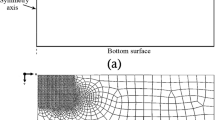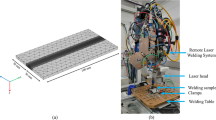Abstract
In this study, a transient unified model including simulation of the temperature, velocity, solute (Mg2Si) concentration and stress fields, free surface, and laser-induced plasma, has been developed to predict the transport phenomena and solidification cracking susceptibility during laser spot bead-on-plate welding of aluminum alloy. The model consists of the modeling of heat, momentum and mass transports in the metal and plasma zones, thermomechanical modeling, and evaluation of solidification cracking. The full set of mathematical equations and numerical methods are presented. The main challenges and the corresponding solutions for the modeling are discussed. In this model, the lever-rule based on the phase diagram was used to deal with the macroscale segregation at the solid–liquid interface, while the solute transfer due to the diffusion and convection were calculated by the conservation equations for transport phenomena. The solute redistribution in the weldment is coupled with the changes of liquidus and solidus temperatures of the material. The total strain consists of the elastic, viscoplastic, and thermal parts that are coupled with the calculated temperature, velocity, and solute in the weldment. The criterion for the weld solidification cracking was established based on the strain theory, in which the cracking initiates only when the strain exceeds the threshold strain in the brittle temperature range (btr).
Similar content being viewed by others
References
Mazumder J (1990) Laser–beam welding. In: ASM handbook, Volume 6, welding, brazing, and soldering. ASM international, pp 262–269
Kawahito Y, Mizutani M, Katayama S (2007) Elucidation of high–power fiber laser welding phenomena of stainless steel and effect of factors on weld geometry. J Phys D Appl Phys 40:5854–5859
Pastor M, Zhao H, Martukanitz RP, DebRoy T (1999) Porosity, underfill and magnesium lose during continuous wave Nd: YAG laser welding of thin plates of aluminum alloys 5182 and 5754. Weld J 78:207s–216s
Zhao H, White DR, DebRoy T (1999) Current issues and problems in laser welding of automotive aluminum alloys. Int Mater Rev 44:238–266
Kou S (2003) Solidification and liquation cracking issues in welding. JOM 55:37–42
Cross CE (2005) On the origin of weld solidification cracking, in: Thomas Böllinghaus, Horst Herolded, Hot cracking phenomena in welds, Volume 1, Springer
Thomas BG (2009) Modeling of hot tearing and other defects in casting processes. In: ASM Handbook, Volume 22A, Fundamentals of Modeling for Metals Processing. ASM International, pp 362–374
Cicală E, Duffetb G, Andrzejewski H, Grevey D, Ignata S (2005) Hot cracking in Al–Mg–Si alloy laser welding–operating parameters and their effects. Mater Sci Eng A 395:1–9
Kim HT, Nam SW, Hwang SH (1996) Study on the solidification cracking behavior of high strength aluminum alloy welds: effects of alloying elements and solidification behaviors. J Mater Sci 31:2859–2864
Yang YP, Dong P, Zhang J, Tian X (2000) A hot-cracking mitigation technique for welding high-strength aluminum alloy. Weld J 79:9s–17s
Ploshikhin V, Zoch HW (2005) Integrated mechanical-metallurgical approach to modeling of solidification cracking in Welds, Hot Crack Phenom Welds 223–244
Ploshikhin V, Prikhodovsky A, Ilin A, Makhutin M, Heimerdinger C, Palm F (2006) Influence of the weld metal chemical composition on the solidification cracking susceptibility of AA6056-T4 alloy. Weld World 50:46–50
Rao ZH, Liao SM, Tsai HL (2011) Modeling of hybrid laser-GMA welding: a review and challenges. Sci Technol Weld Join 16:300–305
Beck M, Berger P, Hügel H (1995) The effect of plasma formation on beam focusing in deep penetration welding with CO2 lasers. J Phys D Appl Phys 28:2430–2442
Tix C, Simon G (1994) Model of a laser heated plasma interacting with walls arising in laser keyhole welding. Phys Rev E 50:453–462
Tix C, Simon G (1993) A transport theoretical model of the keyhole plasma in penetration laser welding. J Phys D Appl Phys 26:2066–2074
Dilthey U, Goumeniouk A, Lopota V, Turichin G (2000) Kinetic description of keyhole plasma in laser welding. J Phys D Appl Phys 33:2747–2753
Fabbro R, Chouf K (2000) Keyhole modeling during laser welding. J Appl Phys 87:4075–4083
Solana P, Negro G (1997) A study of the effect of multiple reflections on the shape of keyhole in the laser processing of materials. J Phys D Appl Phys 30:3216–3222
Semak V, Matsunawa A (1997) The role of recoil pressure in energy balance during laser materials processing. J Phys D Appl Phys 30:2541–2552
Dowden J, Chang WS, Kapadia P, Strange C (1991) Dynamics of the vapor flow in the keyhole in penetration welding with a laser at medium welding speeds. J Phys D Appl Phys 24:519–532
Meng C, Lu FG, Cui HC, Tang XH (2013) Research on formation and stability of keyhole in stationary laser welding on aluminum MMCs reinforced with particles. Int J Adv Manuf Technol 67:2917–2925
Postacioglu N, Kapadia P, Davis M, Dowden J (1987) A keyhole model in penetration welding with a laser. J Phys D Appl Phys 29:340–345
Gao ZG, Wu YX, Huang J (2009) Analysis of weld pool dynamics during stationary laser-MIG hybrid welding. Int J Adv Manuf Technol 44:870–879
Rohde M, Markert C, Pfleging W (2010) Laser micro-welding of aluminum alloys: experimental studies and numerical modeling. Int J Adv Manuf Technol 50:207–215
Zhou J, Tsai HL, Wang PC (2006) Transport phenomena and keyhole dynamics during pulsed laser welding. ASME J Heat Trans 128:680–690
Duley W (1999) Laser welding. Wiley, New York
Martin CL, Favier D, Suéry M (1999) Fracture behavior in tension of viscoplastic porous metallic materials saturated with liquid. Int J Plast 15:981–1008
Martin CL, Braccini M, Suéry M (2002) Rheological behavior of the mushy zone at small strains. Mater Sci Eng A 325A:293–302
Ni J, Beckermann C (1990) A volume-averaged two-phase model for transport phenomena during solidification. Metall Trans B 22:349–361
Farup I, Mo A (2000) Two-phase modeling of mushy zone parameters associated with hot tearing. Metall Mater Trans A 31A:1461–1472
Nicolli LC, Mo A, M’Hamdi M (2005) Modeling of macrosegregation caused by volumetric deformation in a coherent mushy zone. Metall Mater Trans A 36A:433–441
Suyitno KWH, Katgerman L (2005) Hot tearing criteria evaluation for direct-chill casting of an Al-4.5 Pct Cu alloy. Metall Mater Trans A 36A:1537–1546
Fjaer HG, Mo A (1990) ALSPEN-A mathematical model for thermal stresses in direct chill casting of aluminum billets. Metall Trans B 21B:1049–1061
Tan L, Zabaras N (2005) A thermomechanical study of the effects of mold topography on the solidification of aluminum alloys. Mater Sci Eng A 404:197–207
Gao ZH (2012) Numerical modeling to understand liquation cracking propensity during laser and laser hybrid welding (I). Int J Adv Manuf Technol 63:291–303
Chiang KC, Tsai HL (1992) Shrinkage-induced fluid flow and domain change in two-dimensional alloy solidification. Int J Heat Mass Tran 35:1763–1769
Wang Y, Tsai HL (2001) Impingement of filler droplets and weld pool dynamics during gas metal arc welding process. Int J Heat Mass Transf 44:2067–2080
Flemings MC, Nereo GE (1967) Macrosegregation. Trans AIME 239:1449–1461
Flemings MC (1974) Solidification process. Metall Trans 5:2121–2134
Flemings MC (1990) Behavior of metal alloys in the semisolid state. Metall Trans A 22A:957–982
Beckermann C (2002) Modeling of macrosegregation: applications and future needs. Int Mater Rev 47:243–261
Lesoult G, Gandin CA, Niane NT (2003) Segregation during solidification with spongy deformation of the mushy zone. Acta Mater 51:5263–5283
Kumar KCH, Chakraborti N, Lukas H, Bodak O, Rokhlin L (2005) Aluminum–magnesium–silicon, In: Materials science international team MSIT, light metal ternary systems: phase diagrams. Crystallographic and thermodynamic data
Zhang J, Fan Z, Wang YQ, Zhou BL (2001) Equilibrium pseudobinary Al–Mg2Si phase diagram. Mater Sci Technol 17:494–496
Torrey MD, Cloutman LD, Mjolsness RC, Hirt CW (1985) NASA-VOF2D: a computer program for incompressible flows with free surfaces, LA-10612-MS, Los Alamos National Laboratory
Knight CJ (1979) Theoretical modeling of rapid surface vaporization with back pressure. AIAA J 17:519–523
Landau LD, Lifshitz EM (1980) Statistical physics. Pergamon
Kaplan A (1994) A model of deep penetration laser welding based on calculation of the keyhole profile. J Phys D Appl Phys 27:1805–1814
Siegel R, Howell JR (1992) Thermal radiation heat transfer, third ed. Hemisphere Publishing Corp
Pellini WS (1952) Strain theory of hot tearing. Foundry 80:125–199
Eskin DG, Katgerman SL (2004) Mechanical properties in the semi-solid state and hot tearing of aluminum alloys. Prog Mater Sci 49:629–711
Mondolfo LF (1976) Aluminum alloys, structure and properties. Butterworth’s, London
Welch JE, Harlow FH, Shannon JP, Daly BJ (1966) The MAC method. A computing technique for solving viscous, incompressible, transient fluid-flow problems involving free surfaces. Los Alamos Report No LA-3425
Author information
Authors and Affiliations
Corresponding author
Rights and permissions
About this article
Cite this article
Liu, J., Rao, Z., Liao, S. et al. Modeling of transport phenomena and solidification cracking in laser spot bead-on-plate welding of AA6063-T6 alloy. Part I—the mathematical model. Int J Adv Manuf Technol 73, 1705–1716 (2014). https://doi.org/10.1007/s00170-014-5924-2
Received:
Accepted:
Published:
Issue Date:
DOI: https://doi.org/10.1007/s00170-014-5924-2




